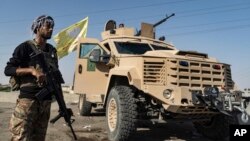Kurdish-led Syrian forces have announced the end of a weeklong operation in eastern Syria to put down an attempted revolt by elements of a local affiliate, though analysts say the U.S.-backed group still faces major challenges in the Arab-majority region.
The Syrian Democratic Forces, or SDF, on Wednesday said it had concluded its military campaign in the eastern province of Deir el-Zour, while continuing a sweeping operation at a flashpoint town in the restive region.
The Britain-based Syrian Observatory for Human Rights, which has researchers on the ground, said Thursday that the fighting between the SDF and former members of an allied militia had left at least 90 people dead.
The clashes erupted last week between the SDF and its Arab-led affiliate, the Deir el-Zour Military Council, after the former removed the council’s commander, Ahmed al-Khubail, also known as Abu Khawla, from his post. The SDF accused Abu Khawla and several other local leaders of criminal activity, corruption and having connections with the Syrian government and Iranian-backed militias.
The SDF is a Kurdish-led military alliance that has been a major U.S. partner in the fight against the Islamic State terror group. Supported by a U.S.-led global coalition, the SDF has controlled large parts of territory once controlled by IS, also known as ISIS or Daesh.
US position
Amid last week’s clashes, the U.S.-led Combined Joint Task Force-Operation Inherent Resolve, or CJTF-OIR, called for an immediate end to the violence.
“It is imperative that all local leaders resist the influence of malign actors who promise many rewards but will deliver only suffering to the peoples of the area,” CJTF-OIR said in a statement. “This poses dire consequences and only allows for a situation that nobody welcomes — the resurgence of our common enemy — Daesh.”
The U.S. has about 900 troops in northeast Syria, including in Deir el-Zour, as part of continued efforts to combat IS remnants.
Hoshang Hasan, a reporter at the local North Press agency, said the “important thing right now is to return stability to that part of Syria, because IS could take advantage of the recent chaos by regrouping and waging attacks.”
But experts said the recent episode of violence in Deir el-Zour highlighted the precariousness of the coalition’s position.
“It really relies on cohesion between the Kurdish-led portions of the SDF and the Arab tribes in Deir el-Zour,” said Calvin Wilder, an analyst at the New Lines Institute for Strategy and Policy in Washington. “If one side or the other breaks away, then the project is going to struggle to stay viable for any length of time.”
Deepened tensions
Deir el-Zour’s residents are primarily ethic Arabs, but the SDF is strongly under the control of Kurdish groups.
“Even the SDF claims about having currently suppressed the uprising, I think the resentment is there, and there is a potential for another round of unrest to happen,” said Aymenn Jawad al-Tamimi, a Syria researcher at Swansea University in Britain.
“The uprising episode showed that there are locals who just won’t be satisfied with the SDF at all. Their preference is they just want the SDF entirely out of Deir el-Zour,” he told VOA.
Kurdish leaders blamed the Syrian government and Iranian-backed militias, who control parts of Deir el-Zour, for destabilizing the situation in areas under SDF’s control.
“We have evidence that proves fighters from regime-held areas were crossing the Euphrates River into our areas,” said Ilham Ahmed, executive president of the Syrian Democratic Council, the political wing of the SDF.
She told VOA that those fighters had been sent by the government of Syrian President Bashar al-Assad and its main backer, Iran, to target the SDF and U.S. troops.
But Wilder of the New Lines Institute said, “There will be a temptation to believe claims that the uprising is entirely a product of malign Iranian or Assadist influence and use that as a pretext to decisively crush it without listening to or addressing any of the local grievances that fueled the fighting.
“Damascus and Tehran are attempting to foster instability for their own gain, but that doesn't explain the recent fighting on its own,” Wilder said.
He said the tensions in Deir el-Zour started in 2017 after the consolidation of the SDF as the dominant military force in northeast Syria, noting that such tensions also could be attributed to the SDF’s ideological commitments to secularism, democratic confederalism and a specific understanding of women’s empowerment.
“Tribal leaders in Deir el-Zour chafed at the idea of a new, Kurdish-led government attempting to spread its sociopolitical vision in their territory, even if they had areas of mutual agreement - in particular, strong opposition to both ISIS and the Assad regime,” Wilder said.
“The most important thing for the United States to do is to maintain its position as a mediator and push both sides [the SDF and local leaders] to negotiate actively and in good faith.”
VOA’s Zana Omer contributed to this report from Hasakah, Syria.









